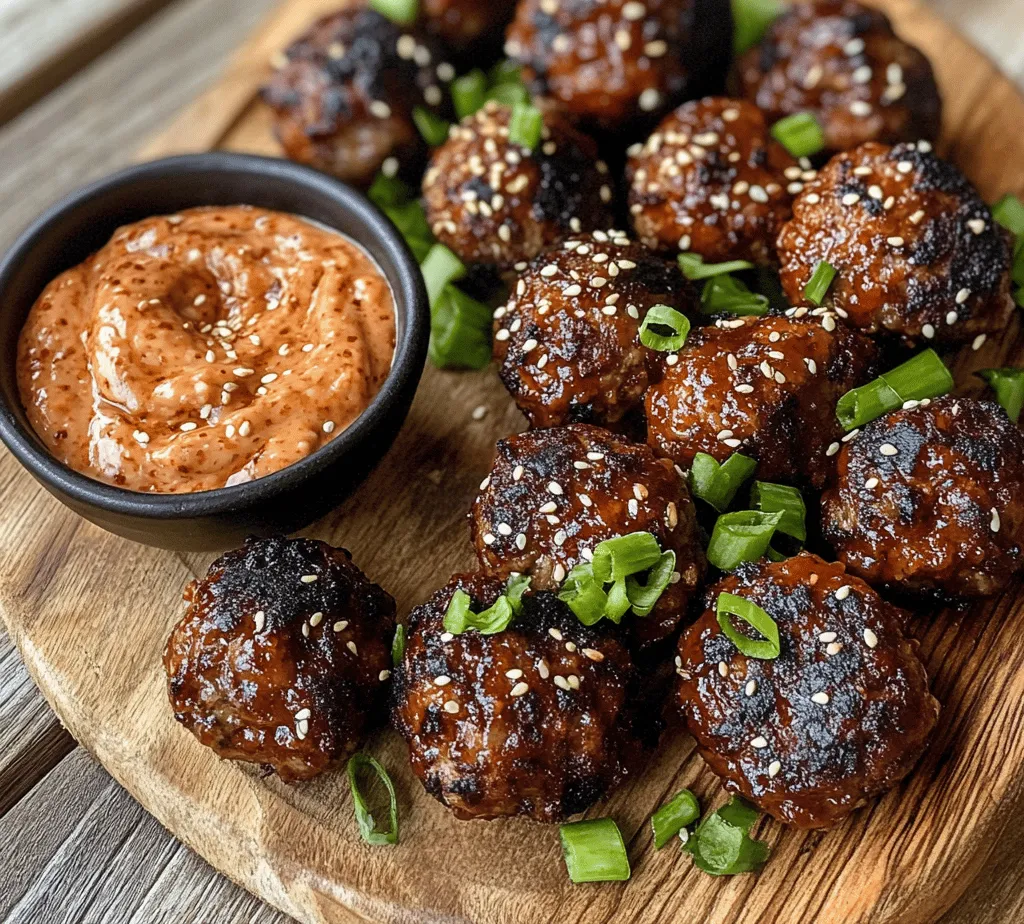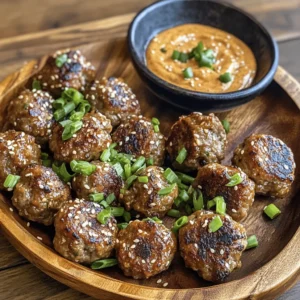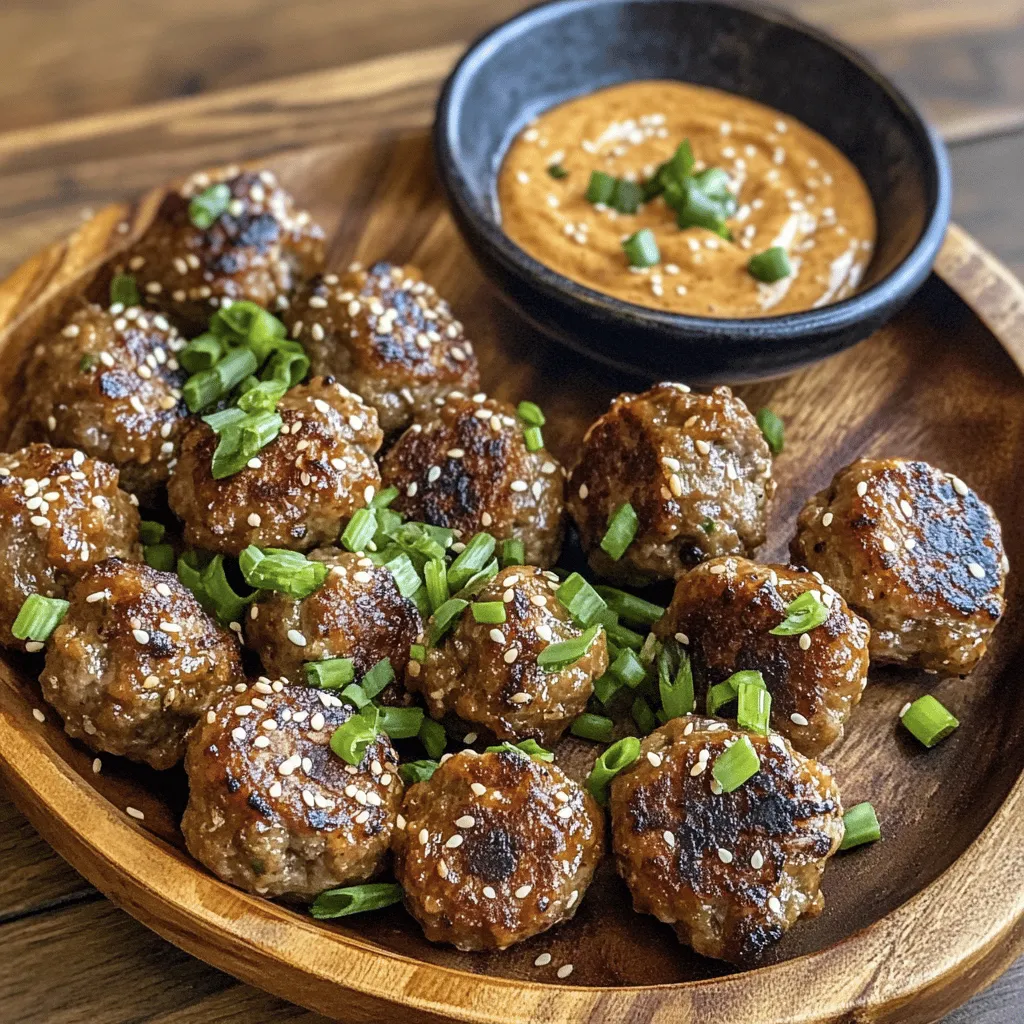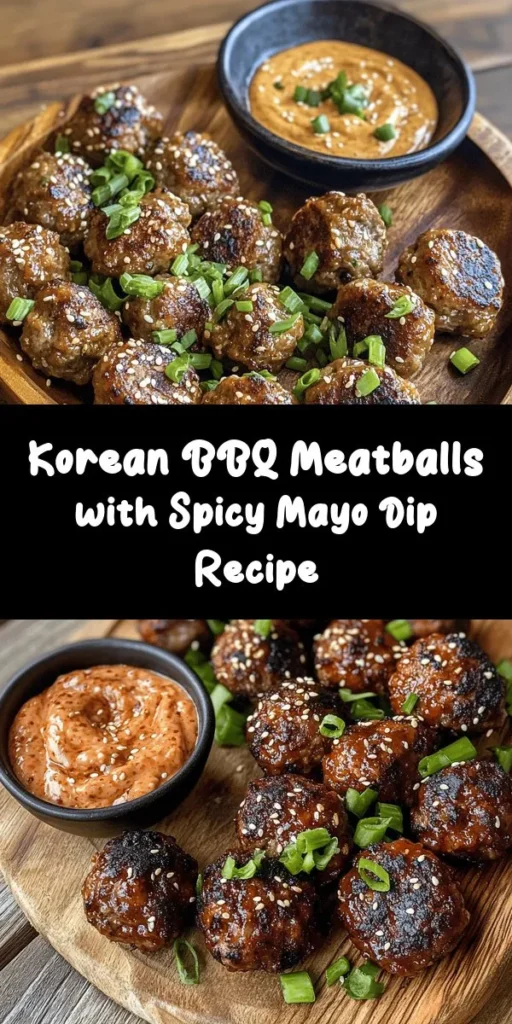Korean BBQ Meatballs with Spicy Mayo Dip is a delightful fusion dish that brings the bold flavors of Korean cuisine right to your kitchen. This recipe brings together juicy, flavorful meatballs made from ground beef or pork, infused with the traditional seasonings of Korean BBQ, and pairs them with a creamy, spicy dip that perfectly complements their richness. Whether you’re hosting a gathering, preparing a family meal, or simply craving something comforting and delicious, these meatballs are sure to impress your guests and satisfy your taste buds.
Korean cuisine is celebrated for its vibrant flavors and unique combinations of ingredients, and this dish encapsulates many of those elements. The meatballs are seasoned with a blend of soy sauce, sesame oil, garlic, and ginger, which creates a savory and aromatic base. The spicy mayo dip, on the other hand, adds a creamy texture and a kick of heat that elevates the overall dining experience. Not only is this dish incredibly tasty, but it also allows for creativity and personalization, making it a versatile option for any occasion.
In this article, we’ll delve deeper into the ingredients, preparation methods, and variations of this dish. We will also explore the cultural significance of Korean BBQ in culinary traditions, providing context for the flavors and techniques that make these meatballs so special.
Understanding Korean BBQ
The Cultural Significance of Korean BBQ
Korean BBQ, known as “Gogi-gui,” is more than just a way of cooking; it’s a social experience that brings people together. Traditionally, this style of dining involves grilling various types of marinated meats at the table, often accompanied by an array of side dishes known as “banchan.” These side dishes can include pickled vegetables, kimchi, and rice, all of which enhance the meal’s flavor and offer a harmonious balance.
The practice of Korean BBQ reflects the importance of community and shared meals in Korean culture. Gathering around a grill fosters conversation and connection, making it a cherished activity for friends and family alike. This communal aspect is a significant reason why Korean BBQ has gained popularity worldwide, allowing diners to engage in an interactive cooking experience while enjoying delicious, flavorful dishes.
Exploring the Origins of Korean BBQ
The roots of Korean BBQ can be traced back to the 1940s when Korean immigrants began to adapt traditional grilling techniques using available ingredients in their new environments. This style of cooking was heavily influenced by the marinated meat dishes of Korean royalty, which were often grilled over an open flame. Over the decades, Korean BBQ evolved, integrating regional flavors and cooking methods, leading to the diverse and beloved cuisine we know today.
In contemporary Korean dining, BBQ has become synonymous with celebration and special occasions. Restaurants specializing in Korean BBQ have emerged around the globe, exposing more people to the rich tapestry of flavors and cooking techniques that define this culinary tradition.
The Role of Meatballs in Korean Cuisine
While meatballs may not be a traditional dish in Korean cuisine, they have found their way into the hearts (and bellies) of many food lovers. The combination of ground meat with aromatic herbs and spices can be found in various forms across many cultures. In Korea, meatballs can be likened to “tteokgalbi,” which are grilled short rib patties, showcasing the same principles of flavor and preparation.
Korean BBQ meatballs are a modern twist on this concept, allowing for a fusion of flavors that appeal to both traditionalists and adventurous eaters. The incorporation of Korean BBQ flavors into meatballs offers a convenient and satisfying way to enjoy these beloved tastes, making them a popular choice for parties and family meals.
Ingredients Breakdown
To create Korean BBQ meatballs with spicy mayo dip, you’ll need a selection of high-quality ingredients that contribute to the dish’s unique flavor profile. Below, we break down the necessary components for both the meatballs and the dip.
Key Ingredients for the Meatballs
Ground Beef or Pork: Choosing the Right Meat
The foundation of any great meatball is the choice of meat. For this recipe, you can use either ground beef or ground pork, or even a combination of both for a richer flavor. Ground beef offers a robust taste and a firmer texture, while ground pork adds a subtle sweetness and tenderness that can enhance the overall mouthfeel of the meatballs. Aim for meat with a moderate fat content (around 80/20) to keep the meatballs moist and flavorful during cooking.
Breadcrumbs: The Binding Agent
Breadcrumbs are essential for holding the meatball mixture together while ensuring a tender texture. They absorb moisture from the other ingredients, keeping the meatballs from becoming dry. You can use regular or panko breadcrumbs; panko will give the meatballs a lighter texture due to its larger, airier flakes. For a gluten-free option, consider using almond flour or crushed gluten-free crackers.
Soy Sauce and Sesame Oil: Essential Flavor Enhancers
Soy sauce is a staple in Korean cooking, providing a deep umami flavor that enhances the richness of the meat. Sesame oil, on the other hand, adds a nutty aroma and flavor that is characteristic of many Korean dishes. Together, these ingredients create a flavor base that elevates the meatballs from ordinary to extraordinary.
Aromatics: Garlic, Ginger, and Green Onions
Fresh aromatics are crucial for achieving the authentic taste of Korean BBQ meatballs. Minced garlic and ginger bring a pungent warmth, while chopped green onions offer a fresh, slightly peppery note. These ingredients not only contribute to the flavor but also add depth and complexity to the dish.
Sweetness and Binding: Brown Sugar and Egg
A touch of brown sugar balances the savory elements of the meatballs, adding a hint of sweetness that complements the soy sauce. Additionally, an egg acts as a binder, helping to hold the meatball mixture together while also contributing to its moisture and richness.
Ingredients for the Spicy Mayo Dip
Mayonnaise: The Creamy Base
Mayonnaise serves as the foundation of the spicy dip, providing a rich and creamy texture that contrasts beautifully with the savory meatballs. For a lighter option, you can substitute Greek yogurt for mayonnaise, which will also add a tangy flavor.
Sriracha: Adding the Heat
Sriracha is the star ingredient in the spicy mayo dip, contributing a bold heat that can be adjusted based on your taste preferences. If you’re looking for a milder dip, simply reduce the amount of Sriracha, or you can experiment with other hot sauces to find the one that suits your palate best.
Flavor Enhancers: Lemon Juice and Honey
To elevate the flavors of the spicy mayo dip, a splash of lemon juice adds brightness and acidity, cutting through the richness of the mayonnaise. A drizzle of honey introduces a touch of sweetness that balances the heat of the Sriracha, creating a well-rounded flavor profile.
Step-by-Step Preparation
Once you have gathered all your ingredients, it’s time to dive into the preparation of these delicious Korean BBQ meatballs and the accompanying spicy mayo dip. Below are the detailed steps to create this mouthwatering dish.
Preparing the Meatball Mixture
1. Combining Ingredients for Optimal Flavor:
In a large mixing bowl, combine the ground meat with breadcrumbs, soy sauce, sesame oil, minced garlic, minced ginger, chopped green onions, brown sugar, and the egg. Use your hands or a spatula to gently mix the ingredients until they are just combined. Be careful not to overmix, as this can lead to tough meatballs.
2. Importance of Not Overmixing:
The key to tender meatballs lies in the mixing technique. Overmixing can result in a dense texture, while gently combining the ingredients allows for a light and airy meatball. Aim for a uniform mixture where the ingredients are evenly distributed without being overly compacted.
Forming Perfect Meatballs
3. Techniques for Uniform Sizing:
To ensure even cooking, it’s essential to form meatballs that are uniform in size. A standard size for meatballs is about 1-1.5 inches in diameter. You can use a cookie scoop or your hands to portion the mixture. Roll each portion gently between your palms to create a smooth, round shape.
4. Tips for Handling the Meat Mixture:
Keep a bowl of water nearby to moisten your hands if the meat mixture sticks. This will make it easier to form the meatballs without them falling apart. Place the formed meatballs on a parchment-lined baking sheet, making sure to leave some space between each one for even cooking.
Baking Meatballs to Perfection
5. Baking the Meatballs:
Preheat your oven to 400°F (200°C). Once your meatballs are shaped and placed on the baking sheet, bake them for about 20-25 minutes or until they reach an internal temperature of 160°F (71°C). Baking the meatballs allows for a healthier preparation compared to frying while still achieving a beautiful golden-brown exterior.
As the meatballs bake, the flavors meld together, creating a delicious aroma that will have everyone eagerly anticipating the final dish. Stay tuned for the next segment, where we will cover the preparation of the spicy mayo dip and how to serve these delectable meatballs for maximum enjoyment.

Optimal Baking Techniques for Even Cooking
Achieving perfectly cooked Korean BBQ meatballs requires attention to baking techniques that ensure even cooking throughout. Start by preheating your oven to 400°F (200°C). This temperature is ideal for allowing the meatballs to cook through without drying out, ensuring they remain juicy and flavorful.
When placing the meatballs on a baking sheet, use parchment paper or a silicone baking mat to prevent sticking and facilitate easy cleanup. Arrange the meatballs with enough space between each one (approximately 1-2 inches) to allow heat circulation. This spacing is crucial for even cooking, as overcrowding the pan can lead to steaming rather than baking. For best results, consider using a convection oven if available, as the fan helps circulate hot air, promoting uniform browning and cooking.
To further enhance even cooking, rotate the baking sheet halfway through the cooking time. This simple step ensures that all sides of the meatballs receive equal exposure to the heat source. Generally, the meatballs will take about 20-25 minutes to cook, but keep an eye on them as oven temperatures can vary.
Identifying Doneness and Achieving a Golden-Brown Exterior
The visual cues of doneness are especially important when it comes to meatballs. They should be golden brown on the outside and firm to the touch. To confirm they are fully cooked, use an instant-read thermometer; the internal temperature should reach 165°F (74°C). This ensures that the meat is safe to eat while keeping it moist and tender.
To achieve that coveted golden-brown exterior, consider broiling the meatballs for the last 2-3 minutes of cooking. Keep a close eye on them during this stage to prevent burning. The broiler will caramelize the sugars in the marinade, resulting in a delicious crust that enhances both flavor and texture.
Creating the Spicy Mayo Dip
Now that the meatballs are cooking to perfection, let’s focus on the spicy mayo dip that will elevate this dish. This dip is a harmonious blend of creamy, spicy, and savory flavors that pairs beautifully with the rich taste of Korean BBQ meatballs.
Balancing Flavors for the Ultimate Dip
To create the spicy mayo dip, start with a base of mayonnaise. Use about 1 cup of mayonnaise, then add 2-3 tablespoons of gochujang (Korean chili paste) for a depth of flavor and heat. Gochujang not only adds spice but also a sweet and savory element that complements the meatballs perfectly.
Next, incorporate 1 tablespoon of rice vinegar to introduce a tangy note, balancing the richness of the mayo and the heat from the gochujang. For an extra kick, add a splash of sesame oil, which brings a nutty undertone that enhances the overall flavor profile. Mix these ingredients in a bowl until smooth and well combined.
Tips for Adjusting Spiciness to Personal Preference
Spice levels can vary greatly among individuals, so feel free to adjust the amount of gochujang according to your taste. For those who prefer a milder dip, start with just 1 tablespoon and taste before adding more. Conversely, if you enjoy a fiery kick, you can increase the gochujang or even add a dash of sriracha for additional heat.
If you want to introduce more flavor complexity, consider mixing in finely chopped green onions or a sprinkle of garlic powder. These additions can enhance the dip’s flavor without overwhelming the primary ingredients.
Serving Suggestions
Once your meatballs are out of the oven and the spicy mayo dip is ready, it’s time to focus on presentation and pairing.
Garnishing the Meatballs
Garnishing plays a crucial role in elevating the visual appeal of your dish. After plating the meatballs, sprinkle a handful of sesame seeds over them. Toasted sesame seeds not only add a delightful crunch but also provide a contrast to the meat’s texture.
Chopped green onions are another excellent garnish. Their vibrant green color brightens the dish and adds a fresh flavor that complements the richness of the meatballs. You can mix the sesame seeds and green onions together for a beautiful topping that enhances both taste and aesthetics.
Presentation Ideas for an Attractive Serving Platter
For an impressive presentation, arrange the meatballs on a large serving platter. You can create a dip bowl in the center for the spicy mayo, surrounded by the meatballs. Consider adding a few fresh cucumber slices or carrot sticks around the meatballs for a pop of color and a refreshing crunch.
Using decorative serving dishes can also enhance the overall dining experience. Choose plates or bowls that reflect the Korean theme, such as those made from stoneware or traditional ceramics.
Pairing with Sides and Beverages
To create a well-rounded meal, consider pairing your Korean BBQ meatballs with complementary side dishes. Traditional sides include:
– Kimchi: This fermented vegetable dish adds a spicy, tangy kick that contrasts nicely with the sweetness of the meatballs.
– Rice: Steamed white or brown rice acts as a neutral counterpart, soaking up the flavors and providing a satisfying base.
– Vegetable Stir-fry: A quick stir-fry of seasonal vegetables adds color and nutrition, fitting perfectly with the Korean BBQ theme.
For beverages, consider serving:
– Korean Soju: This traditional distilled spirit pairs well with the dish’s flavors and can be enjoyed chilled or mixed in cocktails.
– Green Tea: A hot or iced green tea is a light option that complements the meal without overpowering it.
– Korean Beer: A crisp lager, such as Hite or Cass, can refresh the palate and enhance the dining experience.
Variations and Adaptations
One of the best features of Korean BBQ meatballs is their versatility. You can easily modify the recipe to suit different dietary preferences or ingredient availability.
Exploring Alternative Ingredients
If you’re looking to switch up the protein, consider using ground turkey or chicken instead of beef. These alternatives can provide a leaner option while still maintaining great flavor. For a plant-based choice, substitute with lentils or chickpeas, blending them with breadcrumbs and seasonings to create a satisfying meatball texture.
For gluten-sensitive individuals, use gluten-free breadcrumbs and tamari instead of soy sauce. These substitutions will help maintain the integrity of the dish while catering to dietary restrictions.
Adjusting Spice Levels
As mentioned earlier, spice levels can be tailored to fit personal preferences. You can also experiment with flavor profiles by adding different spices to the meatball mixture, such as garlic powder, ginger, or even herbs like cilantro for a fresh twist.
If you want to create a sweeter version of the spicy mayo dip, try incorporating a bit of honey or maple syrup. This addition can balance out the heat and create a unique flavor that pairs well with the meatballs.
Nutritional Information
Understanding the nutritional content of your Korean BBQ meatballs can help you make informed choices. Here’s a breakdown of the calories and nutrients typically found in a serving:
– Calories: Approximately 250-300 calories per serving (4-5 meatballs with dip).
– Protein: Around 15-20 grams, depending on the meat used.
– Fat: About 15 grams, primarily from the meat and mayonnaise.
– Carbohydrates: Approximately 20 grams, mainly from breadcrumbs and any added sauces.
These meatballs are a rich source of protein, making them a satisfying meal option. The inclusion of ingredients like green onions and sesame seeds adds essential vitamins and minerals, while the use of leaner meats can decrease overall fat content.
Conclusion
Korean BBQ Meatballs with Spicy Mayo Dip is a versatile and enjoyable recipe that captures the essence of Korean flavors while being accessible for home cooks. With its simple preparation steps and ability to cater to various dietary preferences, this dish is perfect for any occasion. Whether served as an appetizer, a snack, or a main course, it delivers a satisfying experience that showcases the rich culinary traditions of Korean BBQ.
By following this guide, you can create a delicious dish that not only pleases the palate but also brings people together around the table. Enjoy the process of crafting these flavorful meatballs and dip, and don’t hesitate to experiment with variations to make this recipe your own.



